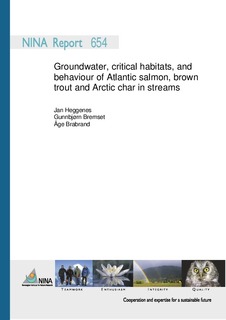| dc.description.abstract | Heggenes, J., Bremset, G. & Brabrand, Å. 2010. Groundwater, critical habitats, and behaviour
of Atlantic salmon, brown trout and Arctic char in streams. – NINA Report 654, 28 pp
Streams are characterized by turbulent hydraulic forces, varying discharge and temperatures, short water retention times, bedload transport and dynamic channel morphology. Alluvial groundwater is more stable with laminar flow, longer residence times, less variable tempera-tures, and constant sediment structure. Surface waters and groundwaters are closely connected in the hyporheic ecotone which can act as a source or sink, depending on complex physical and chemical spatial and temporal patch characteristics, direction and volume of flows, in-substrate pore space and connectivity, and movement patterns of organisms. Outflow-ing groundwater provides base flows, differs in temperature, dissolved oxygen levels and water quality from the surface water. Areas of groundwater inflow may at times provide moderated habitat conditions and possibly refugia for mobile stream salmonids. A literature review suggests that groundwater may be important to salmonids by 1) modulating temperatures, 2) influencing water quality (nutrients, oxygen), 3) providing river base flows, and 4) providing refugia. It is well documented that salmonids may use groundwater inflow sites for behavioural thermoregulation to avoid near-lethal temperatures, and maintain energetically favourable body temperatures. Such thermoregulation may be effected through short vertical movements into the substrate, in particular for small fish, or through longer longitudinal movements. Such behaviour is observed during summer high temperatures and low flows, and at the onset of winter and ice formation. Actual field documentation varies among species, but it is likely a general behavioural strategy in mobile salmonids. Because of the local complexity in surface-subsurface and hyporheic flow connectivity and pattern in space and time, in situ studies are required. Spawning site selection, egg burial, overwinter egg survival and hatching time may be affected by groundwater inflow. However, the spatial and temporal complexity of groundwater flow integrated over time is a research challenge. It is well documented that groundwater flow may be critical in lacustrine spawning habitats. A general conclusion cannot be reached for lotic spawning habitats, probably because it varies locally. The importance of groundwater in providing baseflows in summer and winter is rather obvious. Evidence with respect to the hyporheic refuge hypothesis is scarce and equivocal. Increasing evidence corroborates the function of the hyporheic zone, and associated groundwater flows, as a refugium for macroinvertebrates during low flow events in summer. However, little is known as to how young salmonids may use the hyporheic habitat in summer. In winter, the hyporheic zone is largely a daytime refuge for stream salmonids. Surprisingly, there is a lack of studies to substantiate the hypothesis that fish and macroinvertebrates may take refuge in the hyporheic zone in response to other environmental stressors, e.g. adverse chemical conditions. KEY WORDS : groundwater, streams, substrate, hyporheic zone, juveniles, salmon, trout, char | nb_NO |
